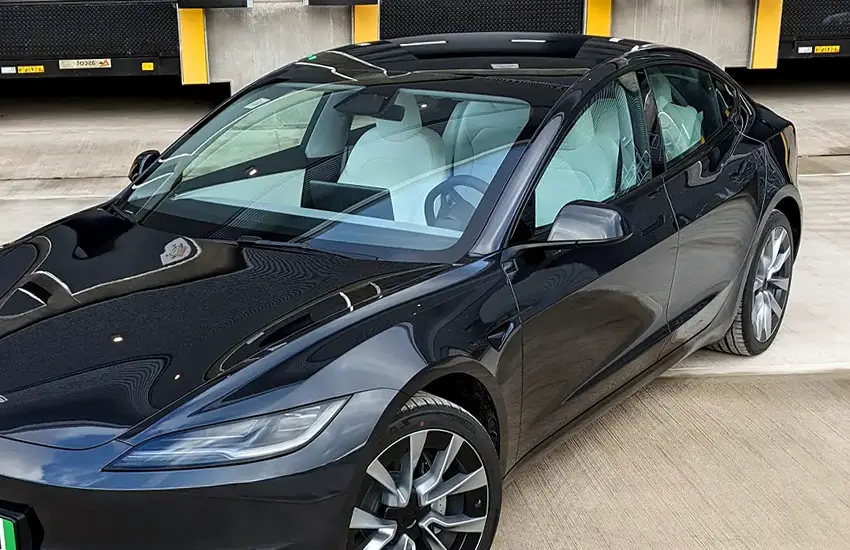As an Amazon Associate, I earn from qualifying purchases at no extra cost to you.
How Much Does a Tesla Battery Weigh? An In-Depth Exploration
Electric vehicles (EVs) are transforming the way we think about transportation. They're cleaner, more energy-efficient, and often packed with the latest technology. Tesla, one of the most well-known electric car manufacturers, is leading the way with its high-performance vehicles. One of the most common questions people have when it comes to Teslas is: How much does a Tesla battery weigh?
The weight of a battery is crucial in understanding the performance, range, and efficiency of an electric vehicle. In this detailed guide, we'll explore the different types of Tesla batteries, the factors that affect their weight, and how this weight impacts the overall performance of Tesla vehicles. From the Model 3 to the upcoming Cybertruck, we'll cover it all, providing you with a comprehensive overview of Tesla battery weights.

Tesla Battery Types and Their Differences
Tesla produces a variety of vehicles, each equipped with different battery sizes depending on the model and configuration. These batteries are the heart of Tesla's impressive performance and driving range, but their weight varies significantly between models. Let's break down how Tesla's different vehicles are equipped with batteries and how their weight affects performance.
The Standard Battery Pack (Tesla Model 3)
The Tesla Model 3 is one of the most popular electric cars on the market, and it offers a variety of battery configurations. The weight of the battery in the Model 3 varies based on the model variant and the size of the battery pack.
Standard Range Plus: The Standard Range Plus Model 3 comes with a smaller battery pack compared to its Long Range and Performance counterparts. The battery weighs around 1,000 pounds (450 kg), and the pack is designed to provide a balance between cost, range, and performance. With a smaller battery, the car remains lightweight enough to be agile while still delivering a decent range of approximately 250 miles on a single charge.
Long Range and Performance: The Long Range and Performance versions of the Model 3 come with larger batteries, generally around 75 kWh, and weigh significantly more—approximately 1,200 pounds (545 kg). These models offer a longer driving range, from 350 miles to 400 miles on a single charge, but they also need the larger battery to meet the power demands of the vehicle's performance and range capabilities.
Tesla has designed the Model 3 with weight in mind, ensuring that despite the increased weight of the battery in certain models, it still manages to maintain good acceleration, handling, and overall driving dynamics. The battery's placement under the floor of the car provides a low center of gravity, which helps improve the vehicle's handling and safety.
Larger Battery Packs in Model S and Model X
The Tesla Model S and Tesla Model X are higher-end vehicles that require significantly larger battery packs to support their bigger, heavier builds and more powerful performance. These two models typically have battery packs that weigh between 1,200 to 1,500 pounds (545 to 680 kg), depending on the variant and battery capacity.
Model S: The Model S comes in different versions with varying battery capacities. The Long Range Plus version features an 85 kWh battery pack, which weighs approximately 1,200 pounds (545 kg). For the higher-performance versions, like the Performance model, the battery size increases to around 100 kWh, which results in a heavier pack and an even greater range of approximately 370 miles.
Model X: The Model X, Tesla’s electric SUV, requires a much larger battery due to its size and weight. It comes with a battery pack of around 100 kWh and weighs approximately 1,500 pounds (680 kg). This large battery supports the Model X's larger frame while also providing the vehicle with enough energy for its impressive range of about 340 miles.
These vehicles also use Tesla’s battery technology to offer enhanced acceleration and performance, despite their larger size. The additional battery weight allows these models to carry more passengers, provide faster acceleration, and ensure that they can achieve long distances between charges.
Tesla Cybertruck and Semi Truck Battery Weight
Tesla is also preparing to launch two game-changing vehicles: the Cybertruck and the Tesla Semi. Both of these vehicles will require massive battery packs to support their size, weight, and high performance.
Tesla Cybertruck: The Cybertruck, Tesla's futuristic electric pickup truck, is expected to come with a 200 kWh battery pack, which will weigh anywhere between 1,500 to 2,000 pounds (680 to 900 kg). This large battery is necessary to power the truck for extended ranges and tough performance on rough terrain. The battery also needs to support heavy towing and off-road capabilities, both of which require significant energy reserves.
Tesla Semi: The Tesla Semi, an electric big rig, will have a significantly larger battery pack to support its heavy-duty hauling capabilities. Early estimates suggest that the battery pack will weigh around 4,000 pounds (1,800 kg), given the energy demands required to transport large loads across long distances. Tesla has designed the Semi to be as efficient as possible, with the battery enabling it to travel up to 500 miles per charge while hauling up to 80,000 pounds of cargo.
These vehicles are still in development, but the weight of the battery packs is expected to be a critical factor in their performance, as they will need to support heavy loads and high ranges.
Factors That Influence the Weight of Tesla Batteries
Understanding why Tesla batteries weigh as much as they do requires a look at the factors that contribute to their overall mass. Several key factors influence the weight of these batteries, and it's important to consider each of them when discussing Tesla's battery design.
1. Battery Chemistry and Materials
The primary factor in determining the weight of Tesla batteries is the battery chemistry used to store and release energy. Tesla primarily uses lithium-ion batteries, which are much lighter than older technologies like lead-acid batteries. However, the materials used in lithium-ion batteries, such as nickel, cobalt, and lithium, all contribute to the overall weight of the battery.
Nickel and cobalt are both relatively heavy metals, and large batteries that require more of these materials will naturally weigh more. Tesla has been actively working on reducing the amount of cobalt in its battery packs to lower costs and reduce environmental impact, but the battery still needs these metals for energy storage and efficiency.
In addition, the battery modules are housed in aluminum casings to ensure the pack remains lightweight and durable. Aluminum is used for its strength-to-weight ratio, but the materials inside the battery can still add significant weight.
2. Battery Size and Capacity
The size of the battery pack directly correlates with its weight. Tesla's battery packs range from 50 kWh for the Model 3 Standard Range version to 200 kWh in the Cybertruck and Semi. The larger the battery, the more materials are required to build it, and consequently, the heavier it becomes.
A larger battery can store more energy, which is essential for longer driving ranges, but the added energy storage capacity requires more cells, wiring, and cooling systems, all of which add to the overall weight of the battery pack.
Tesla's Long Range versions of vehicles typically come with larger battery packs, which provide additional range but also result in heavier vehicles overall. This is a trade-off that helps the vehicle travel further without needing to recharge.
3. Battery Cooling and Safety Features
Another important consideration when evaluating battery weight is the cooling system. Tesla batteries generate heat during use, and if they become too hot, they can degrade or even become dangerous. To prevent overheating, Tesla incorporates a sophisticated liquid cooling system within the battery pack.
The cooling system consists of tubes filled with coolant that run through the battery pack. These systems add weight, but they're necessary to ensure the safe operation of the battery and prevent damage from overheating.
Additionally, safety features in Tesla's battery packs, such as reinforced casings and crash protection, also contribute to the overall weight of the battery. While these features add bulk, they are essential for protecting the battery during a collision and ensuring the vehicle's overall safety.
How Tesla Battery Weight Affects Vehicle Performance
The weight of the battery pack impacts several aspects of the vehicle's performance, including its range, acceleration, handling, and overall energy efficiency.
1. Impact on Range
A larger battery pack stores more energy, which directly translates into a longer driving range. However, there's a trade-off between battery size and vehicle weight. Heavier vehicles require more energy to move, which can slightly reduce the overall efficiency of the vehicle.
Tesla engineers work to balance the weight of the battery with the car's design, ensuring that the increased weight does not overly reduce the range. This means that while larger battery packs may weigh more, they are still designed to provide a higher driving range, keeping Tesla vehicles among the best in the industry in terms of efficiency.
2. Acceleration and Handling
The weight of the battery pack also affects how the car performs in terms of acceleration and handling. A heavier battery means that it takes more energy to accelerate the vehicle and maintain its speed, which can affect how quickly the car picks up speed.
However, Tesla vehicles are equipped with powerful electric motors that can handle the additional weight. The large torque provided by the motors ensures that the car can still achieve impressive acceleration figures. The low center of gravity, due to the battery placement under the car, also improves handling by reducing body roll during sharp turns, making the car feel stable despite the added weight.
3. Energy Consumption and Efficiency
Tesla’s engineering focuses on maximizing energy efficiency. A heavier vehicle requires more power to operate, but Tesla's energy management system helps optimize the use of stored energy. Despite the added weight of the battery, the car’s systems ensure that power consumption is kept as low as possible.
Tesla's use of regenerative braking helps recover energy during braking, which further boosts the vehicle's efficiency and range. This system allows the car to recover energy that would otherwise be lost and use it to recharge the battery, offsetting some of the energy demand caused by the added weight.
Are These Questions in Your Mind?
Is it true that the battery weight affects the Tesla’s range?
Yes, the battery’s weight does impact the range, but Tesla designs its vehicles to optimize performance and efficiency despite the additional weight. Larger batteries store more energy, which can extend the driving range.
Can a lighter battery improve Tesla’s performance?
A lighter battery could theoretically improve acceleration and handling, but Tesla's goal is to create a balance between performance, range, and safety. A lighter battery alone would not necessarily lead to better overall performance if it sacrifices energy capacity.
Do I need to worry about the weight of the Tesla battery affecting my driving experience?
Not really. Tesla vehicles are engineered to handle the weight of the battery while maintaining an excellent driving experience. The low center of gravity from the battery pack helps with handling and stability.
Can I replace my Tesla battery with a lighter one?
Currently, Tesla batteries are designed for specific models, and there's no easy way to swap them out for a lighter one. The battery size is tailored to the car's energy requirements and performance needs.
Is it safe to drive a Tesla with a heavy battery?
Yes, Tesla batteries are designed with safety in mind. They are reinforced to withstand impact, and the vehicle is engineered to handle the weight of the battery safely.
Do I need a special charger for a Tesla battery?
Tesla vehicles are designed to charge with both Tesla-specific chargers and standard electric vehicle chargers, although Tesla's Supercharger network offers the fastest charging times.
Is Tesla planning to make lighter batteries in the future?
Yes, Tesla is constantly working on improving its battery technology. Advances in battery chemistry, materials, and manufacturing processes may lead to lighter and more efficient batteries in the future.
Can I drive my Tesla after the battery is completely discharged?
No, it's not recommended to completely discharge the battery, as it can damage the battery cells. Tesla vehicles have built-in safeguards to prevent complete discharge, but regular charging is still important for battery health.
Is it possible to recycle Tesla batteries?
Yes, Tesla has made efforts to ensure that its batteries can be recycled. The company uses a sustainable approach to repurpose and recycle old battery cells to reduce environmental impact.
Do I have to replace the battery after a certain number of years?
Tesla batteries are designed to last for many years, often between 8-10 years or more, depending on the model and usage. However, battery performance may degrade slightly over time, and eventually, you may need to replace the battery.
I hope this article has provided a clear understanding of the weight of Tesla batteries and the factors that contribute to it. Whether you’re considering purchasing a Tesla or just curious about EV technology, knowing how battery weight influences vehicle performance and design can give you a deeper appreciation of these innovative machines. Tesla continues to push the boundaries of what's possible with electric vehicles, and their batteries are an essential part of that journey.











